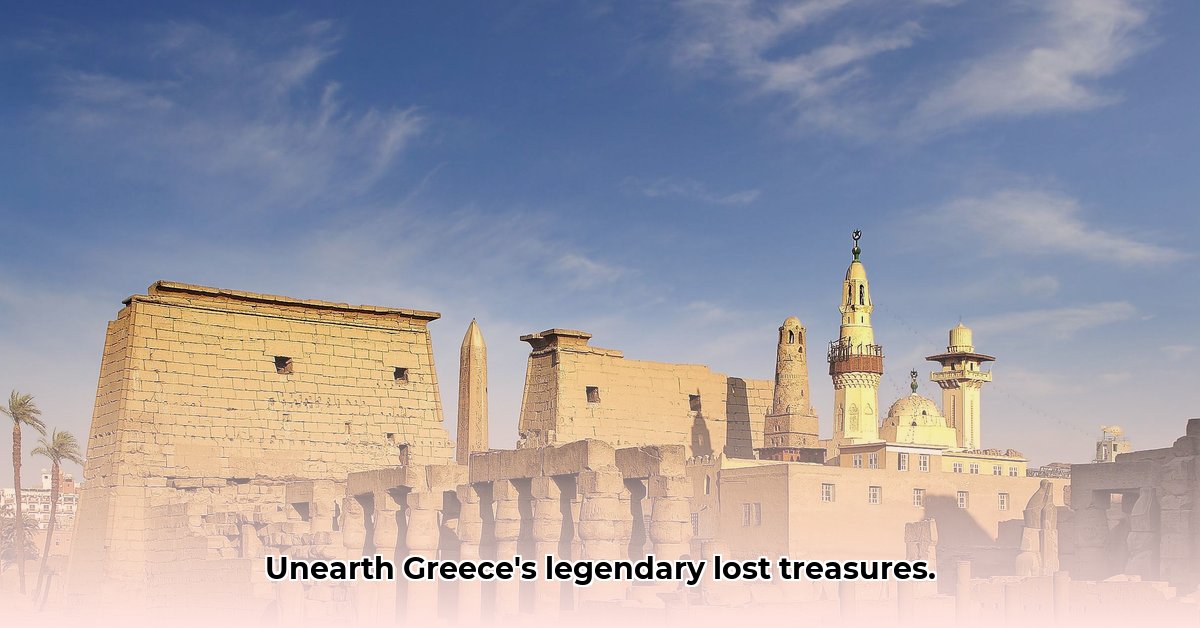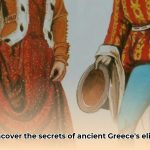Delve into the captivating world of ancient Greece by exploring its most remarkable artifacts, from majestic statues to intricate pottery and sophisticated mechanisms. This article provides a comprehensive exploration of significant ancient Greek relics, examining their historical importance, artistic value, and the enduring mysteries they hold. Prepare to journey through time, uncovering the art, inventions, and lasting legacy of this influential civilization. Learn more about ancient Greek temples here.
Unearthing Ancient Greece: Discoveries and Meanings
Embark on a journey through time to discover the most incredible artifacts unearthed from ancient Greece. These objects offer insight into a remarkable civilization, revealing its artistry, ingenuity, and complex beliefs. What secrets do these treasures reveal about life in ancient Greece, and what challenges do we face in preserving them for future generations?
The Parthenon Marbles: A Story in Stone and Cultural Heritage
The Parthenon Marbles, originally adorning the Parthenon temple in Athens, stand as one of the most prominent ancient Greek artifacts. These sculptures depict scenes from Greek mythology, showcasing the incredible craftsmanship of marble carving. Their history is complex, as they currently reside in the British Museum, their removal from Greece remains a sensitive and contentious issue. Greece advocates for their return, asserting their integral role in the nation’s heritage, while the UK emphasizes the museum’s dedication to preserving and presenting these treasures to a global audience. The debate highlights fundamental questions about cultural heritage and the ethics of artifact ownership.
Diplomatic efforts aim to reconcile historical context with the Greek people’s desire to reclaim their cultural patrimony. Some argue the British Museum enhances the marbles’ artistic reach, while others stress the irreplaceable connection between the artifacts and their original setting for a complete understanding of their profound meaning.
The Elgin Marbles evoke discussions about cultural property rights, national identity, and the colonial past. Advocates for restitution stress that the marbles’ presence in London perpetuates historical injustices and hinders Greece’s ability to fully showcase its cultural heritage. What legal and ethical considerations should guide decisions regarding the repatriation of cultural artifacts?
Venus de Milo: Exploring Art and Ancient Aesthetics
The Venus de Milo, an elegant marble statue of the goddess Aphrodite, is a prime example of ancient Greek artistry. Its graceful form and serene expression have captivated viewers for centuries. The statue’s missing arms add an intriguing layer of mystery. What did they originally hold? How would their presence alter our perception of the goddess? Artists and scholars have proposed countless theories, sustaining the statue’s allure. The incomplete nature of the Venus de Milo invites continuous interpretation, making it an endlessly engaging piece of history.
Some speculate the goddess may have held an apple, a symbol associated with Aphrodite. The lack of definitive answers has allowed this artifact to remain an object of fascination and creative speculation. The Venus de Milo’s impact extends beyond aesthetics. What does its enduring appeal suggest about the timeless nature of beauty and the power of suggestion in art?
The Antikythera Mechanism: Examining Engineering and Ancient Technology
Prepare to be amazed by the Antikythera Mechanism, considered the world’s first analog computer, discovered in a shipwreck. This intricate device, crafted centuries ago, tracked the movements of celestial bodies with accuracy. Its gears and design demonstrate scientific understanding of ancient Greek inventors. This mechanism challenges beliefs about ancient technology. Ongoing study reveals new details about the knowledge and engineering capabilities of ancient Greek civilization.
Scientists use advanced imaging techniques to decipher the mechanism’s capabilities, revealing details about ancient Greek astronomy and mathematics. Its existence sheds light on the intersection of science, technology, and culture in the ancient world. Can the Antikythera Mechanism reshape our understanding of the history of science and technology?
Mask of Agamemnon: Glimpses into Mycenaean Culture and Royal Burials
Unearthed in Mycenae, the golden Mask of Agamemnon offers a look into the Mycenaean civilization. While its connection to the legendary Agamemnon is debated, the mask’s craftsmanship and artistry are undeniable. It symbolizes the artistry, wealth, and funerary rituals of this culture. Its discovery enriched insights into Mycenaean culture, revealing beliefs and burial practices.
Even though associated with Agamemnon, some experts believe the mask may have belonged to someone else of high status. The mask’s enduring presence highlights the allure and mystery surrounding ancient rulers and their burial customs. What does the Mask of Agamemnon reveal about the power structures and artistic achievements of Mycenaean society?
Winged Victory of Samothrace (Nike of Samothrace): Celebrating Triumph and Hellenistic Sculpture
The Winged Victory of Samothrace, depicting Nike (the goddess of victory), is a sculpture of unparalleled dynamism. The goddess’ figure, captured in mid-flight, embodies triumph. Its absence of a head and arms enhances its powerful presence. Displayed at the Louvre Museum, it is a testament to ancient Greek art and its capacity to evoke emotion.
The Winged Victory symbolizes victory, reflecting the values and beliefs of ancient Greek culture. Its architectural placement contributes to its impact. How does the Winged Victory embody the Hellenistic artistic style, and what emotions does it aim to evoke in the viewer?
Temple of Artemis at Ephesus: A Wonder of the Ancient World
The Temple of Artemis at Ephesus, one of the Seven Wonders of the Ancient World, stands as a testament to the grandeur of ancient Greek architecture and religious devotion. Located in present-day Turkey, this colossal temple was dedicated to Artemis, the Greek goddess of the hunt, wilderness, wild animals, the Moon, and chastity. Though only ruins and a single reconstructed column remain today, the temple’s historical significance endures, evoking images of its former magnificence and intricate sculptures.
The temple’s destruction and reconstruction throughout history reflect the tumultuous events of the ancient world, from invasions and conquests to natural disasters. Its architectural design inspired awe and reverence, drawing pilgrims and worshippers from across the Mediterranean world. How did the Temple of Artemis at Ephesus reflect the religious and cultural values of ancient Greek society?
Conclusion: The Enduring Legacy and Continuous Discoveries
These artifacts represent a glimpse of the treasures unearthed from ancient Greece. Each one tells a story, enriching our understanding of this pivotal civilization. Ongoing research and new discoveries ensure narratives surrounding these ancient relics evolve, leaving opportunity for exploration. This continuous unveiling of new facts and interpretations keeps the study of ancient Greece vibrant and exciting.
How to Analyze Ancient Greek Artifact Preservation Challenges
Delve into the world of preserving ancient Greek artifacts, each one an irreplaceable treasure that faces threats, demanding analysis to understand and counteract them. How can we ensure the survival of these pieces of history for future generations?
Understanding the Enemies of Time: Analyzing Degradation Factors
Ancient Greek artifacts are historical records. Their degradation tells a story that we need to understand to protect them.
- Environmental Factors: Sunlight can bleach colors, while shifting temperatures can cause cracking. Humidity promotes mold growth. Environmental assaults are relentless. Analyzing this requires observation of the artifact’s condition, noting changes over time, and correlating them with environmental data.
- Biological Threats: Bacteria, fungi, and insects feast on organic materials like wood, textiles, and paints. We need to identify these biological invaders and develop treatments. Analyzing this necessitates microscopic examination and testing to pinpoint the attackers.
- Human Impact: Improper handling, inadequate storage, and misguided restoration efforts can cause damage. Analyzing this involves examining past handling practices and storage conditions, and evaluating the long-term consequences of restoration techniques.
Analyzing Degradation: A Multi-pronged Approach to Conservation
Effective preservation hinges on thorough analysis.
- Material Identification: Determine the artifact’s composition (e.g., marble, bronze, pottery). This dictates vulnerability to specific threats.
- Damage Assessment: Document existing damage, noting type, extent, and location. Photography and 3D scanning are invaluable.
- Environmental Monitoring: Measure temperature, humidity, and light levels in the artifact’s environment. This clarifies the environmental contribution to deterioration.
- Biological Analysis: If biological agents are suspected, laboratory tests identify the culprits and inform treatment strategies.
- Historical Context: Where was this object found? How was it used in ancient times? This informs our understanding of its past exposure and vulnerability.
- Technological Assessment: Explore the use of non-invasive methods like X-ray, infrared, and multispectral imaging. These assist in observing internal damage without further harm.
Preservation Strategies: Balancing Ethical Considerations and Innovation
We’re active participants in preservation. Traditional techniques remain paramount: climate control, careful handling, and protective casing. Modern technologies offer possibilities:
- Nanotechnology: Nanomaterials might offer targeted protection against degradation, but thorough testing is vital to ensure long-term compatibility.
- Digital Preservation: 3D scanning and high-resolution imaging create digital records. This secures access even if the original deteriorates.
- Preventive Conservation: Proactive measures—improving storage conditions, monitoring environmental factors—prevent further damage.
Ethical Preservation: A Vital Component in Cultural Heritage
Repatriation debates and questions of ownership add ethical complexity. How do we balance preservation with cultural sensitivity and historical justice? Careful analysis of provenance and ownership claims is crucial, demanding transparent and collaborative approaches. We must prioritize respect for the cultural heritage and the rights of communities.
Key Takeaways:
- Understanding the specific threats faced by an artifact is crucial for effective preservation.
- A systematic approach combining traditional and cutting-edge methods is necessary for successful preservation.
- Ethical considerations regarding ownership, repatriation, and the impact of interventions must be carefully addressed.
- Long-term preservation requires ongoing monitoring, adaptation, and collaboration.
Preservation Challenges Facing Ancient Greek Artifacts in Modern Museums
What are the preservation challenges facing ancient Greek artifacts in modern museums?
The Delicate Dance: Balancing Progress and Protection of Antiquities
Modern museums balance protecting priceless artifacts with keeping them accessible. Preservation challenges are numerous and complex. Environmental threats, human impact, and funding issues create a multifaceted challenge for conservators. Museums employ sophisticated environmental controls, but they’re costly and can’t eliminate risk entirely.
Environmental Threats: From Climate Change to Air Quality Management
Heat, cold, humidity, and light can damage these treasures. Even the air we breathe can cause corrosion. Climate change exacerbates these problems, increasing the urgency for robust solutions. How can we create more resilient and sustainable preservation strategies to combat climate change’s impact on these priceless artifacts?
Human Impact: Minimizing Damage, Maximizing Appreciation
While dedicated curators meticulously preserve them, human error and accidental damage are constant threats. Tourists, while well-meaning, can inadvertently cause problems. Looting, the illegal acquisition and sale of artifacts, drains Greece of its heritage. Improved security measures and public awareness campaigns are needed. How can we balance accessibility with the need to protect artifacts from accidental damage and intentional looting?
Technological Advances: Navigating Digital Advancements and Preservation Methods
Digital preservation through 3D scanning and modeling creates virtual copies, allowing for study and access without risking damage to originals. Nanotechnology, while promising in artifact restoration, can cause irreversible damage if improperly applied. Careful testing and collaboration with materials scientists are crucial. How do we ethically and effectively integrate cutting-edge technologies into preservation practices?
The Ethical Tightrope: Repatriation and Ownership in the 21st Century
The debate surrounding the Parthenon Marbles epitomizes the ethical dilemmas. These sculptures are currently housed in the British Museum, leading to calls for repatriation to Greece. This controversy involves questions of ownership, provenance, and international cultural heritage. Transparency regarding artifact origins and international cooperation are essential. What role should museums play in addressing historical injustices related to artifact acquisition and repatriation?
Funding and Resources: Strategies for Ensuring Long-Term Stability
Museums operate on limited budgets, and the cost of maintaining these fragile objects is immense. This influences the quality and comprehensiveness of preservation strategies. How can we secure more stable and sustainable funding models for museum preservation efforts?
Looking Ahead: A Collaborative Path for Future Generations
Preserving Greece’s legacy is a shared responsibility. Collaboration between governments, museums, archaeologists, and the public is crucial. Strengthening laws against looting, increasing transparency, advocating for ethical practices, and securing sufficient funding are essential steps toward ensuring the survival of these treasures.
[https://www.theacropolismuseum.gr/en/conservation-antiquities]1
The Sociopolitical Impact of Ancient Greek Artifact Ownership Disputes
What is the sociopolitical impact of ancient Greek artifact ownership disputes?
The Parthenon Marbles: A Timeless Case Study in Cultural Diplomacy
The ongoing dispute surrounding the Parthenon Marbles illustrates the sociopolitical impact of Ancient Greek artifact ownership disputes. These sculptures, removed from the Parthenon in the early 19th century, are now housed in the British Museum. Greece has long campaigned for their return, framing the removal as an act of cultural vandalism. The British Museum argues it legally acquired them and provides preservation and access. How has the Parthenon Marbles dispute shaped diplomatic relations between Greece and the United Kingdom?
This dispute highlights a divide. Is the location solely about preservation and accessibility, or is cultural significance and historical context more important? Colonialism, cultural heritage, and national identity are also at stake. Who truly owns the past? The Parthenon Marbles dispute has become a symbol of cultural nationalism and the fight for the repatriation of cultural heritage.
Beyond the Marbles: A Wider Perspective on Cultural Heritage
Many other Ancient Greek artifacts are at the center of similar ownership battles, which are deeply political. They force a re-examination of how artifacts were obtained—were they legitimately purchased, or were they acquired under duress or through exploitative practices? These ownership battles have spurred global debates about colonialism, looting, and the ethical responsibilities of museums and collectors.
Returning stolen family heirlooms feel like restoring a piece of history. For Greece, the return of its artifacts is akin to recovering a crucial part of its national identity. To what extent do legal arguments outweigh the moral and cultural claims in artifact ownership disputes?
The Role of International Law and Ethics: Charting a Course for Resolution
There’s no international law providing a solution. Each case hinges on unique circumstances, legal precedents, and political realities. There’s a growing international consensus favoring repatriation when artifacts were acquired unethically. Ethical consideration is increasingly outweighing strict legal interpretations. What legal frameworks exist to protect cultural heritage from illicit trafficking and promote ethical repatriation?
UNESCO is playing a vital role in promoting dialogue, developing ethical guidelines, and facilitating repatriation efforts. Yet, even with these efforts, many challenges remain, including the implementation of international agreements and the enforcement of ethical standards.
Looking Ahead: Finding Common Ground in a Globalized World
Resolving the sociopolitical impact of Ancient Greek artifact ownership disputes requires respecting the cultural significance of artifacts alongside preservation and accessibility. A collaborative approach is needed. Achieving a balance between preservation and repatriation may involve creative solutions, such as long-term loans or collaborative management agreements. How can international collaborations and partnerships foster more equitable and respectful approaches to cultural heritage management?
-
Acropolis Museum. Conservation of Antiquities. Accessed 2025-08-08. ↩
- Uncover Timeless Ancient Greece Female Names: A Guide to Choosing the Perfect Name - August 9, 2025
- Explore Ancient Greece Artifacts: Unveiling Iconic Treasures - August 9, 2025
- Unveiling Ancient Greek Marriage: Customs & Laws Revealed - August 9, 2025
















